|
To recap quickly from Lightcraft, the modern UFO “experience” largely stems from 1965, and not from 1947. The original flying saucer reports between 1947 and 1952 caused a flurry of interest, but the reports were on the whole of silver discs flitting through the atmosphere. They remained something distant, something for debate. But in 1965 it changed. UFOs were seen by thousands. The greatest display was over the nights of August 2 to 3. Longtime Mutual Network radio newsman Frank Edwards estimated that “a quarter of a million people stood out in the Great Plains states of the United States and watched the formation of unusual lights maneuvering overhead. . . .The things were seen with the naked eye and with a wide variety of optical instruments. They were tracked on radar, both civilian and military. They were photographed by both amateur and professional photographers. . .”
The brightly glowing lights hovered, zoomed to high altitude, and sometimes descended so low a silhouette could be made out. It was a solid craft. They appeared to have banks of radiant windows. Others were beautiful lights, mixing and strobing together like a kaleidoscope of agitated watercolors— orange, red, yellow, white, blue and green. But there was some solid object at the core of the ethereal display.
For all intents and purposes, the sightings began on August 1, 1965, over Francis E. Warren AFB, near Cheyenne, Wyoming. Nine glowing objects hovered overhead and then zoomed off with terrific speed. Soon they were over the Army depot at Sidney, Nebraska, about 100 miles east from Cheyenne. Then they returned to the restricted air base and descended on the missile silos. Base personnel were calling Blue Book in Ohio. NORAD picked the objects up on radar, but had no explanation for them. After a couple of hours of this aerial display, five grouped and went westward; four apparently split up and headed eastward.
The next day one was seen and photographed over Sherman, Texas. It dropped a plasma bolt of energy. Aug. 3 one was photographed over Valentine, Nebraska. By August 21, four were photographed hovering off Island Park, New York. They were hemispheric, with bright underbellies. One was glowing red and its glow was turning it into a glowing red orb. Project Blue Book dismissed the photos as reflecting ground lights.
By September 3 a large glowing red orb, so bright that the craft behind it could not be seen, created the “Incident at Exeter,” New Hampshire. The sightings at Exeter culminated in a book by John Fuller, Incident at Exeter. It largely became a benchmark but individual incident within the flap that was unfolding over 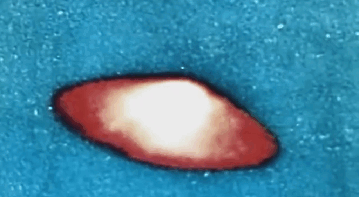 America. America.
The incidents expanded back over the Midwest.
Right, deputy sheriff Arthur Strauch’s dusk photo of a UFO taken near St. George, Minnesota, October 21, 1965. In many ways it fits the Exeter descriptions of a giant glowing football, at least seen from this angle.
Those sightings beginning in August 1965 in the central Midwest earned them the distinction of the Western Flap, but this title was soon obsolete, for the incidents expanded, spreading northward into Michigan and Minnesota, Wisconsin, Iowa, and South Dakota. As a title, the Midwest Flap also didn’t last long. The enormous press coverage given the incidents in New England showed this was a far broader phenomenon. This became the Second Great UFO Flap in history.
Over 1965-1967, three distinct types of craft were involved, each described clearly by multiple witnesses and up close. Two can be established as Lightcraft type devices, the most common being the 12-foot capsule (below, right), which forms the central piece of Lightcraft Project’s own patch. See Lightcraft: a Project of Many Colors. Both the bell and hemisphere were described as “brownish” in color or bronze.
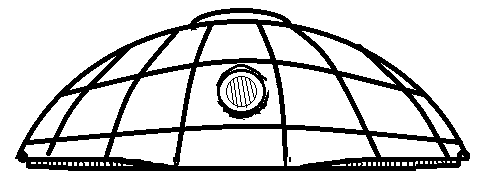 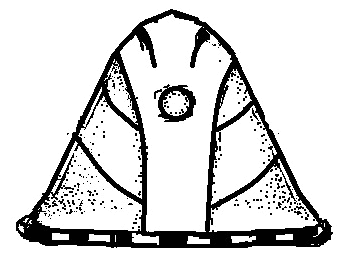
The excitement over these nightly UFOs of many colors in 1965-66 created a furor of interest that extended UFO sightings and a glut of press coverage into 1967. No sightings, however, garnered as much attention and controversy as the Dexter and Hillsdale, Michigan, sightings on March 20 and 21, 1966. Cascading from these sightings was a Congressional hearing, then the Condon Committee, and the era that followed and of which we are still a part. The 25-foot model in particular (above, left) seems to fit the craft seen there.
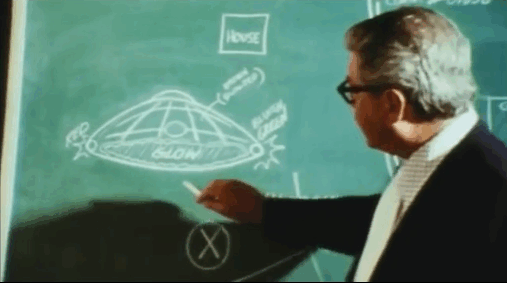
Lt. Colonel Hector Quintanilla here discusses the UFO seen hovering over the swamp at Dexter, Michigan. “Frank Mannor described the object as brown in color, quilted, with a porthole in the center, sorta flat on the bottom, cone shaped towards the top, two small lights, one at each end, one glowing bluish-green, the other a brilliant red, with a glow at the bottom.” Below, right, a somewhat charmingly embellished version of the same by other witnesses at Hillsdale where the object was seen at a greater distance the next night. 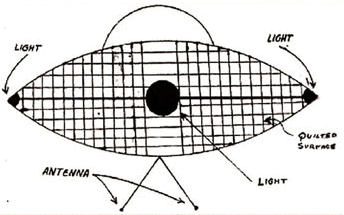
The Great Flap of 1965-1967 was caused by a top secret US operation involving (then) top secret Lightcraft devices. Although this operation’s purpose has never been divulged or admitted to, the involvement of Lightcraft devices is undeniable. As much as 12 years later the same devices were still being used and even photographed in training maneuvers over Kirtland AFB, such as seen in the photograph below by Paul Bennewitz. It matches the UFOs photo’d off New York in August 1965, and along with its proud ‘power node’ glowing red it is evident it is the same object responsible for the pivotal Michigan sightings in March 1966.
That Lightcraft type devices were in action already by 1965 is evident from a UFO report of two similar brown oval objects seen near the north boundary of the White Sands Proving Grounds in New Mexico. The date was May 15, 1964. These objects were observed on radar and visually for 45 minutes, doing “pogo maneuvers.” Saucer buffs investigated and wrote off the sightings as probably helicopters painted brown for some unknown reason. They did so because the airport towers were picking up IFF transponders from the objects. “The visual description of ‘football-shaped’ objects could be consistent with an ovoid helicopter fuselage, tail and rotor assemblies unnoticed due to the viewing angle and/or poor viewing conditions.” However, this description also matches the “UFO” over Dexter— brown/bronze.
Far less subjectively, one of the 12-foot bell shaped capsules crashed at Kecksburg, Pennsylvania, on December 9, 1965.
As we have already seen, Lightcraft seems to have found a lasting home in New Mexico, possibly where the pilots were trained or where the craft underwent some updates. The photo below, left, was taken in 1978 in New Mexico, and it captured the Lightcraft at the perfect moment its forward node was glo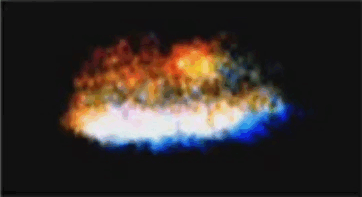 wing red with, apparently, intense energy just like in Michigan in 1966. wing red with, apparently, intense energy just like in Michigan in 1966.
Left, one of the 25-foot Lightcraft type vehicles in operation over Kirtland AFB, and photographed by Paul Bennewitz. Consult Greg Valdez’s book Dulce Base.
The UFO flap beginning in August 1965 and anchored by the Incident at Exeter cut deep into the collective psyche of UFOlogy. Prior to this the emphasis had been on theorizing how silver discs, which formed the bulk of the UFO sightings, could be from outer space. Now the theorizing indulged in wondering why UFOs were coming in close. It was clearly a new phase, one that indicated a more protracted interest in the Earth. The UFO experience was awaiting the ultimate moment: contact.
. . .But it wasn’t happening. Worry took the place of anticipation. After all, UFOs were remaining a phenomenon of rural nights, not city nights. They never made overt contact, but there was no doubt they prowled the outlying areas of our civilization.
Among many significant outcomes, Dr. J. Allen Hynek, long the skeptical official Air Force UFO consultant, would begin to believe that UFOs were real. He would become a powerful voice and the man “who made UFOs respectable.” His endorsement gave more credibility to UFO sightings in the 1970s and 1980s, and the respectability he gave the pursuit allowed it to weather some of its worst chapters and folklore.
Before his conversion, Hynek was the establishment. He was director of the Dearborn Observatory and professor of Astronomy at Northwestern University in Evanston, Illinois (near Chicago). In 1948 he had been at U of Ohio (Columbus). Because he was an astronomer and located relatively near to Dayton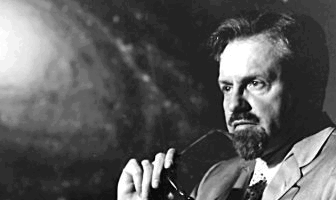 , where the Air Force UFO investigations were based, he was chosen as their consultant, practically from the beginning of the saucer phenomenon. His name was known by all in the saucer business. His pronouncements had become a bulwark to promoting an incident as of extraterrestrial origin. He was the “scientific expert” for the Air Force. He delighted in debunking, and he admitted it. , where the Air Force UFO investigations were based, he was chosen as their consultant, practically from the beginning of the saucer phenomenon. His name was known by all in the saucer business. His pronouncements had become a bulwark to promoting an incident as of extraterrestrial origin. He was the “scientific expert” for the Air Force. He delighted in debunking, and he admitted it.
Hynek often appeared in a very staid, reflective pose, with pipe or glasses in hand.
To follow his conversion is to illustrate the damning significance of Lightcraft and the Second Great UFO Flap in history it sired. His conversion is a reflection of the nation’s conversion, and it can be easily followed due to his publicity as the chief Air Force consultant.
In response to the Exeter sightings (1965), and the growing Western Flap, he appeared on Your Right To Say It, a Chicago based TV show, in November 1965. Dr. Hynek repeated his assurance to the audience that “we are not being visited by people from outer space.” He also admitted that UFOs do exist, but they do so only as reports and not as real objects. Some of the people reporting them were quite impressive in their intelligence and training. Therefore he felt there was much to be gained in studying people who report UFOs, more so than studying UFO reports. The inference was rather evident. The growing number of qualified people reporting UFOs in 1965 implied that there could be great discoveries made in studying their psychological processes. In other words, something has to account for credible people seeing incredible things.
Hynek’s comments are an infallible reflection of his personal contemporary point of view. This negative view about UFOs being real is also echoed in his press comments of March 1966 concerning the UFO over Dexter and Hillsdale, Michigan. He suggested “swamp gas” as a possible explanation for 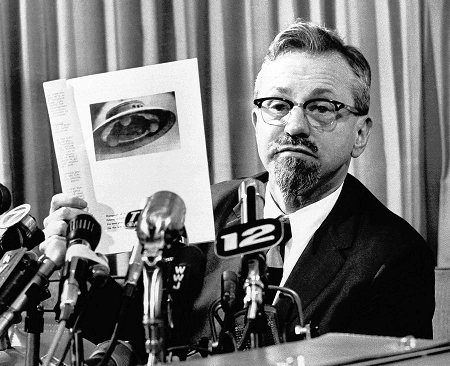 the Dexter sighting. That comment earned him worldwide ridicule. Even Gerald Ford felt that the Air Force could do better than such an explanation. the Dexter sighting. That comment earned him worldwide ridicule. Even Gerald Ford felt that the Air Force could do better than such an explanation.
In the midst of the Great Flap (March 1966), Hynek caused chortles at this press conference by likening this flying saucer to a chicken feeder.
At the Congressional hearings starting April 5, 1966, Hynek declared that for 20 years he had tried to be open-minded about UFOs though the subject “seemed utterly ridiculous.” However, he felt great knowledge could have been overlooked because the Air Force’s “working hypothesis” was that all UFOs were hoaxes, misidentifications, and errors. It had been a very successful approach from a PR point of view, “but it could have been a roadblock to valuable research. If one digs too intently for coal, one is apt to overlook diamonds. . . And in dealing with truly puzzling cases, we have tended to either say that, if an investigation had been pursued long enough, the misidentified object would have been recognized, or that the sighting had no validity to begin with.” He pointed out that Blue Book really didn’t investigate UFOs. “Enough puzzling sightings have been reported by intelligent and often technically competent people to warrant closer attention than Blue Book could encompass. . .”
As the hearings continued, Hynek was still playing with his theory that people who reported flying saucers should be studied. He admitted to the committee that he could not explain the Exeter sightings. Then when asked to comment on some of the 20 cases he had submitted as truly puzzling, he mentioned a case where four witnesses, including two university students, had seen a UFO presenting 4 red lights and 1 large white light approach their car. “I questioned these people for some two hours. They were very intelligent.”
NICAP’s The UFO Investigator summed up Hynek’s attitude to this case in their May/June 1966 issue. “After appearing to accept their report, Hynek reversed himself and rejected it. ‘Why would they be the only four people to see this? . . .Was this some sort of strange psychic projection, or something these people were particularly prone to? . . . I find it most difficult to ascribe a physical tangibility that there was an actual craft there. I would rather seek some other scientific explanation.”
The above is a ludicrous, even disturbing, rationalization from a man who outright didn’t accept UFO reports as anything tangible. Essentially, by the time of the Congressional hearings in April 1966 Hynek still held his view as expressed on Your Right To Say It the November before. People who saw UFOs should be studied.
In response to the question whether these UFOs ever indicated any extraterrestrial intelligence behind them, he implicitly admitted to his non belief. He told the committee he’d seen no evidence for that, but as an hypothesis it should be considered. “I don’t think we should ever close our minds to it.”
For the ardent UFO followers, Hynek seemed to be softening his tone.
By August 1966, Hynek had really changed. The UFO Investigator’s August/September front page headlined with HYNEK HITS UFO INVESTIGATION, CONFIRMS EVIDENCE.
In a series of surprising public statements, Dr. J. Allen Hynek, Chief AF-UFO consultant, has revealed a “pattern” found in numerous sightings, admitted the existence of unexplained UFO photos and radar trackings, and called for an end to ridicule of reliable witnesses.
Many reported UFOs, the AF expert stated, have been so close that configurations, such as oval shapes, were clearly visible. Other close-range pattern details, he said, included flashing lights and UFO movements, such as hovering and rapid take-offs.
“This pattern suggests that something is going on,” said Dr. Hynek. But in calling for an improved scientific investigation he did not in any way imply that the ‘something’ may involve danger.
“I refuse to push the panic button,” he emphasized, “but I must discharge my responsibilities by stating the facts as I know them.”
Such a remarkable change came over only a few months and it would only increase over the months to come. Science published his letter on October 21, 1966, wherein he declared that the UFO phenomenon cannot be “dismissed with a shrug.” He also called for a “meaningful scientific investigation of the residue of puzzling 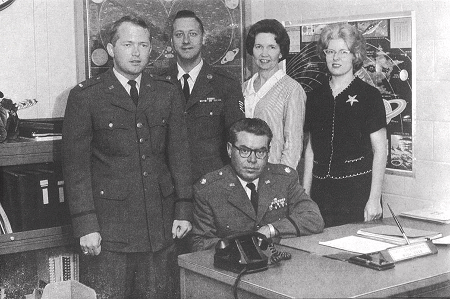 UFO cases.” UFO cases.”
Blue Book staff, including Maj. Hector Quintanilla (seated), SSgt. Harold T. Jones, and secretary Marilyn Stanscomb (far right). Hynek’s increasingly demeaning comments about BB were irritating Quintanilla.
On January 6, 1967, Hynek was the guest speaker at NASA’s Goddard Space Flight Center. Speaking to an audience of 1,000 people, he declared UFOs a “scientific problem.” He reiterated they exist as reports, but now he has had to revise his thinking based on the 5 to 10 percent that are truly puzzling cases (i.e. they might be real). He encouraged the scientific community to move from passive to active and take seriously the reports of UFOs. There were enough rational people reporting them to distinguish them from the noise of the crackpots who are active in the field. These rational reports indicate a clear signal. He told the crowd at Goddard that the phenomenon was centuries old and he didn’t want to be looked upon by future generations for overlooking such a phenomenon. He reiterated the AF investigation was shallow. “He strongly shied away from the extraterrestrial hypothesis, however,” as The UFO Investigator summed up his dissertation in the January 1967 issue: “Hynek Speaks Out.”
How could he declare with such verve the importance of the subject and then avoid the one theory that made UFOs so poignant? Hynek was not following any progressive logic, likely because he was only in the early stages of his conversion. He was beginning to believe witnesses because of the large number of clear and concise reports, but these type of reports were a rather new thing in a field hitherto dominated by kooks. He still couldn’t accept the most ridiculed theory, however. What is the alternative then?
Hynek had no investigative ability to probe into secret military intelligence projects, and the UFO community, quickly gathering around him, was always equally quick to assert we had no such advanced technology that would look like flying saucers and glowing UFOs. Hynek listened but tried to remain cautiously aloof and independent. Still, in a subject matter that lacked loud, credible voices in science, Hynek’s new homilies for serious research were well received and reported.
Due to the Michigan sightings, a brash scientist entered the field, Dr. James E. MacDonald. In an April 22, 1967, talk at the U of Arizona, he became combative with Major Hector Quintanilla, head of Project Blue Book. Quintanilla asserted Blue Book had been scientific. “Balderdash,” replied MacDonald. MacDonald also said that his 12 month intensive investigation had revealed that the AF never went to the best scientists to explain anything— a silent dig at Hynek’s reputation.
One can well imagine that Quintanilla bit his tongue. He didn’t like Hynek and saw little value in him. Quintanilla was sometimes quite rude to him when he visited Wright-Patterson AFB and chatted with his staff. As far as Quintanilla was concerned, Hynek merely gossiped with them. He was only an astronomer and wasn’t qualified to investigate most of the sightings anyway. He had even traveled on the AF purse to investigate the Socorro Landing in New Mexico, and Hynek wasn’t qualified at all for such investigation. Quintanilla wanted many scientists as consultants, each in their special field of expertise. Hynek got a lot of 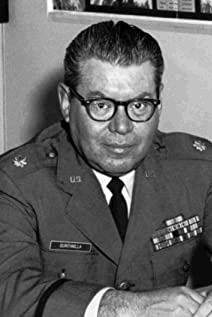 attention, but he simply was not qualified. As Hynek was becoming more vocal about Project Blue Book’s shallowness, Quintanilla was apparently getting bolder (at least behind-the-scenes) about Hynek’s actual and largely useless level of input into Blue Book. attention, but he simply was not qualified. As Hynek was becoming more vocal about Project Blue Book’s shallowness, Quintanilla was apparently getting bolder (at least behind-the-scenes) about Hynek’s actual and largely useless level of input into Blue Book.
Hector Quintanilla was the last chief of Blue Book before it was shuttered. He was Hynek’s least favorite. He had had great respect for Major (later Lt. Colonel) Robert Friend, who was head between 1959 and 1963.
In the December 1967 issue of Playboy, Hynek declared that UFOs would push mankind toward “the greatest adventure since dawning human intelligence turned outward to contemplate the universe.” As he turned more favorable, civilian UFO journals like A.P.R.O.’s Bulletin and NICAP’s The UFO Investigator continued to write him up positively. “A long-time skeptic, the Northwestern astronomer has been making a series of surprisingly positive statements on the subject, calling for a serious scientific investigation, citing Air Force incompetence, and admitting that ‘there are at least 1,000 reports that remain completely unresolved in my own mind.’”
Congress had commissioned the Condon Committee during its April 1966 hearings, named after its head, Dr. E.U. Condon of the U of Colorado, to assess all the data and come to a conclusion. Now in early 1968 as the ongoing Condon Committee was coming under more criticism for being biased, Hynek again got in the pro-saucer news. “In a courageous new declaration, Dr. J. Allen Hynek— AF Chief Scientific Consultant on UFOs— has made this surprising disclosure. If the Colorado Project’s conclusion is completely negative-denying UFO reality, he will ‘take the wraps off’ his personal files of good unexplained cases and make them public. If Hynek took this drastic step it would certainly be a bombshell. He has already revealed that he has over 1,000 cases he considers completely unresolved— a large number from impressive sources.” (Jan-Feb 1968 The UFO Investigator.)
And indeed in 1969 the Condon Committee was completely negative in their report. Hynek would publish his first book The UFO Experience: a scientific inquiry in 1972 and become the man “who made UFOs respectable.” His book was widely read and contained many of these cases he considered unexplained. It was, in essence, a peek behind how Blue Book had operated, coming from the man who had been for over 20 years touted in the press as the Air Force’s scientific expert.
Longtime pro-saucer followers were delighted, but memories are short. Hynek’s conversion was only a few years old. He went from trying to dismiss UFO reports as astronomical bodies (1947-1965) to opting to believe in outlandish psychological explanations for multiple witness sightings (1965-1966) to account for the new clarity of sightings.
It was Michigan 1966 and the clarity of the sightings there and the certainty of the people who had reported them that started Hynek on his road to take UFOs seriously. Yet what he said early on in April 1966 before Congress still rings true. “And in dealing with truly puzzling cases, we have tended to either say that, if an investigation had been pursued long enough, the misidentified object would have been recognized . . .”
The Michigan sightings that anchor the entire Great Flap of 1965-1967 can now be identified. And this name is Lightcraft. Only a small amount of evidence has been presented on it at the afore-linked page. But volumes exist within the annals of the UFO phenomenon describing UFOs according to the known design and performance of the 12-foot bell and the 25-foot hemisphere models.
Paul Bennewitz’s photos and descriptions confirm these two models of Lightcraft remained the mainstay of the design. His photos and their context constitute tangible evidence, and this section of the Quester Files (as it was made clear in Overview) is about pursuing the tangible evidence.
In deference to this, in Lightcraft III Janus Point we look at reports that identify variations of the above models. In these cases, they sport a flange. Extrinsically, these reports bear on Lightcraft because the Lightcraft design can be easily altered to make it look like the quintessential domed flying saucer. Moreover, these “saucers” were in action in the same general areas or followed similar (or exact) courses as those of Lightcraft.

As an example or, more accurately, a foretaste above, an alteration of the 25-foot hemisphere Lightcraft shows how it takes on the traditional aspects of a flying saucer.
Aside from clear and reliable eyewitness reports of such “saucers” during 1965-1967, there is another example that reflects how often and clear these Lightcraft style saucer sightings were. This is found in 1970s illustrations of UFOs. Whether the witness had seen the craft out of doors or, on some tantalizing occasions in an Air Force base hangar, we get undeniable likenesses to Lightcraft bells and, in the picture below, right, to the 25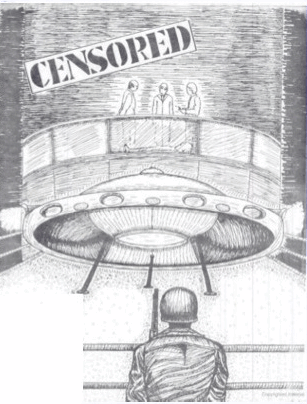 -foot hemisphere sporting an otherwise purposeless flange. This UFO/flying saucer is portrayed here in infamous Hangar 18 at Wright-Patterson AFB in Dayton, Ohio. -foot hemisphere sporting an otherwise purposeless flange. This UFO/flying saucer is portrayed here in infamous Hangar 18 at Wright-Patterson AFB in Dayton, Ohio.
Lightcraft’s theorized propulsion system is a pulse-ion engine. Repeated sightings and photographs prove it has no moving parts or wings; together, this makes it quite adaptable to airframe modification. Altered with nonessential avionics turns the two Lightcraft models into a number of otherworldly and even confusing designs. If its intent was to be that of a spy craft and low altitude intelligence gatherer, the multiplicity of designs would also confuses its (earthly) origins.
The Cold War was hot now due to Vietnam. Political assassinations were rocking the USA. War protests increased. Central Intelligence had roped into its circle ugly minds who could come up with many guises to intimidate enemies and conceal the hand of US operations. One of psychological warfare’s primary uses was in counter-insurgency. For a plan to overthrow the government of Castro, Jacques Vallee notes (Messengers of Deception) that there was a “harebrained” plan to fake the Second Coming of Christ (witness before Senator Frank Church’s committee). Various and gruesome counter-insurgency tactics were used in Vietnam, one involving gouging out the eyes of killed Vietcong in order to prey upon the local superstition of the “evil eye.” Most macabre was in counter-insurgency against the Huks in the Philippines. Special forces faked vampirism:
The enemy dead were strung upside-down from the limbs
of trees, and their jugulars pierced with small incisions.
Found days later by their comrades, their bodies drained
of blood and with what seemed to be “teeth-marks” on
their necks, the dead were presumed to have fallen victim
of immortal enemies.
The quote above is taken (appropriately) from Jim Hougan’s Thirty-Four Spies from Mars, page 39.
By 1965, the flying saucer phenomenon and its effects on populations had been around for 18 years, providing much inspiration for Intelligence schemes. But around just as long, if not longer, was scientific knowledge into how saucers could actually work. Therefore during the Second Great Flap we have insights into the origins of a third type of novel vehicle reported. Though it had been around in public (and scientific) discussions since 1950, it was described and photographed clearly during this Great Flap of 1965-1967 for the first time, leaving no doubt, to the informed, the science had come to fruition.
-----------------------------------------------------------------------------------------------------
1955: CIA Dir. Allen Dulles, Col. Edward Lansdale USAF, CIA Deputy Dir. General Charles Cabell, General Nathan Twining, Chief of Staff USAF. Lansdale masterminded some of the strangest psychological warfare ideas against the Huks, Castro, and in Vietnam. Twining was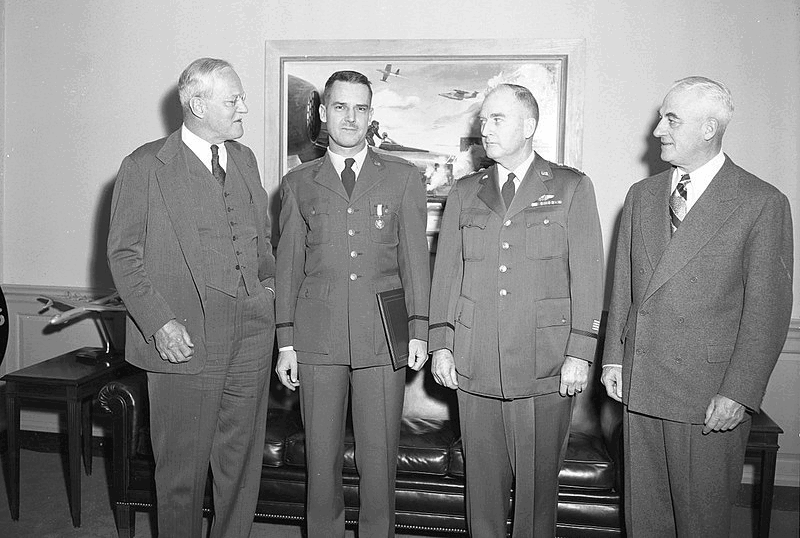 well informed in 1947 about the potential of flying saucer designs. The question was their use. well informed in 1947 about the potential of flying saucer designs. The question was their use.
In 1959 Colonel Joseph Bryan joined NICAP. Rare for a military man, he was vociferous that UFOs were interplanetary, a contradiction to the official Pentagon view. He worked his way into conspiracist Donald Keyhoe’s confidence quickly as a result.
Mass UFO sightings over Lockheed’s skunkworks in February 1957 had an obvious effect on any Pentagon Intelligence observer. In November 1957 these same type of UFOs begin causing UFO sightings at Levelland, Texas.
By 1959 the Air Force was anticipating the 1960s would be the era of UFOs. This prescience slipped out unintentionally. In March 1960, NICAP’s The UFO Investigator reported: “In private instructions briefing AF commands, Maj. Gen. Richard E. O’Keefe, Acting Inspector General, recently warned that UFO sightings will increase, causing public apprehension. Conceding that UFOs are a serious problem, he emphasized the need for speedy investigations by experienced officers with special equipment.”
NICAP informed the mainstream press with the above on February 27, 1960, and supplied photocopies of the briefing order dated December 24, 1959, titled UFOs: SERIOUS BUSINESS. As the Great Flap of 1965-1967 was at its height, Mutual Network’s Frank Edwards published his bestseller Flying Saucers— Serious Business, reminding the reader the title was based on the Air Force’s own secret assessment.
Col. Joseph Bryan’s joining NICAP fits within this distinct chronology. During this time, he had been appointed to the Board of Governors on NICAP because of his unflinching view that UFOs were interplanetary. The May-June 1966 issue of The UFO Investigator spotlighted Bryan, interestingly, at the height of the flap. A write-up of his distinguished career with the Navy and then later with the Air Force, plus his popular writing career (he had worked with or been published by many mainstream magazines) was 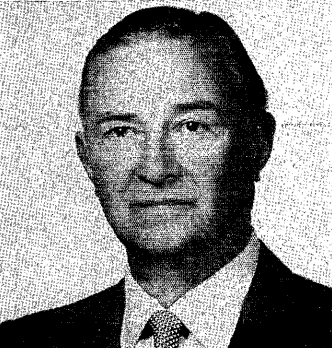 followed by his own personal statement, which included: “These UFOs are interplanetary devices systematically observing the Earth, either manned or under remote control, or both.” It was rare dogma by a ranking military man coming, again, at the precise moment the public wanted answers. followed by his own personal statement, which included: “These UFOs are interplanetary devices systematically observing the Earth, either manned or under remote control, or both.” It was rare dogma by a ranking military man coming, again, at the precise moment the public wanted answers.
It took a former NSA employee, Todd Zechel, to discover in 1973 that Bryan had actually been the first Chief of the Psychological Warfare Staff for the CIA (1948-1953). Keyhoe had been unaware of Bryan’s secret past. Bryan would prove significant in removing Keyhoe and bringing about NICAP’s downfall.
Taken in retrospect, by 1959 the groundwork was being laid for the massive use of Lightcraft, including using it as a cover to encourage the ET hypothesis. Simultaneously there began the infiltration and monitoring the best UFO groups who fielded and investigated independently the majority of UFO sightings.
-----------------------------------------------------------------------------------------------------
It is necessary here to amplify deputy sheriff Art Strauch’s photo on October 21, 1965. It is tangible and therefore of equal interest as Paul Bennewitz’s photos. It is one of the best photos, and it is a contemporary photograph during the Second Great Flap, the flap which has led us on the path to the present.
Reports of flying saucers as domes with an encircling rotating outer disc became quite clear in 1950. Electrical physicist Wilbert Smith explained in detail to arch saucer writer Donald Keyhoe how such a saucer was drawing energy by collapsing the Earth’s magnetic field. He and his team of developers in Canada called it a “magnetic sink.” He described the corona plasma it would generate. We already saw in Overview how reports of this type of saucer were clearest near Boeing’s plant at Wichita, Kansas, in 1950 and were completely at odds with the original description of “flying saucers.” (See Unifying Clue, but please read links in order first).
The existence of such a saucer in 1965 is a disturbing coincidence that points to a very earthly science behind it, especially when there is a photo confirming a couple of understandable points— a critical one is the presence of an air scoop in front. This feature mimics the design of Avro Canada’s conventional flying saucer design, which was based on a central rotating jet turbine, with air scoop in front. This could not generate enough lift to make it a success. But a rotating disc collapsing the magnetic field, as discussed by Wilbert Smith, is another matter. What Strauch saw and photographed 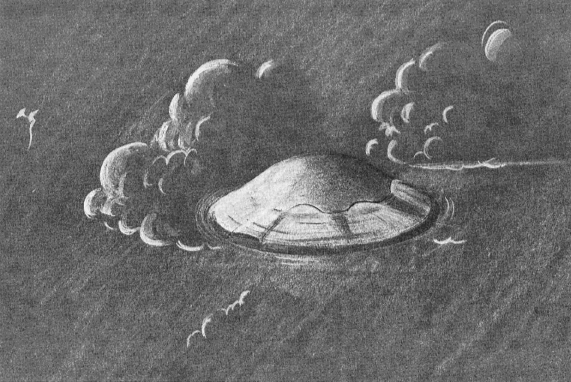 was an electromagnetic and smaller version of the principles in the jet designed Avro, with a central rotating disc taking the place of the rotating jet turbine, held in place by struts connected to the rim. was an electromagnetic and smaller version of the principles in the jet designed Avro, with a central rotating disc taking the place of the rotating jet turbine, held in place by struts connected to the rim.
Deputy sheriff Strauch’s photo is of a discus-like object that is essentially a glowing plasma mass. The core is yellow-white light and the perimeter is red. Yet through binoculars, this is what Strauch saw: “The rounded top of the dome was a metallic silver gray that reflected the rays of the setting sun, turning it into a large orange ball. Surrounding the dome were four small portholes that emitted a bright yellow light. Just below the windows or ports was an area that glowed a light blue. This light seemed to be a reflection of some inner light or perhaps exhaust. From the edge of the blue light’s reflection to the edge of the flat saucer surface (outer edge) the outer ring was rotating counterclockwise, causing it to throw off an aurora or halo of light that changed from orange to white with an overall tinge of blue and green.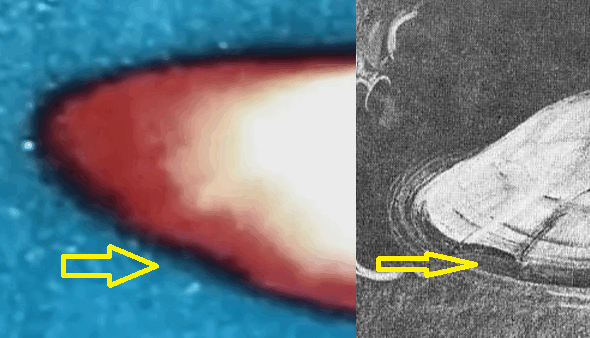 The extreme outer edge of the saucer glowed a bright orange and this part did not move or rotate.” The extreme outer edge of the saucer glowed a bright orange and this part did not move or rotate.”
A. P. R. O.’s staff artist Richard Beal drew this illustration (above, left) of the saucer deputy sheriff Strauch saw behind the glow. Strauch saw the air intake port clearly. The saucer also made some kind of noise like an electrical engine starting up (possibly because of this intake). Strauch noted you can see the indent of the intake port on the color photo but not the other details of what he saw through binoculars.
The design is completely understandable. The disc is held together rim to dome by the struts and under them (seen through the archways between the struts) the disc rotates, generating energy. In essence, the saucer is a combination of the science reflected in General Nathan Twining’s September 23, 1947, memorandum. “It is possible within the present U.S. knowledge— provided extensive detailed development is undertaken— to construct a piloted aircraft which has the general description of the object in subparagraph (e) above [Circular or elliptical in shape, flat on bottom and domed on top]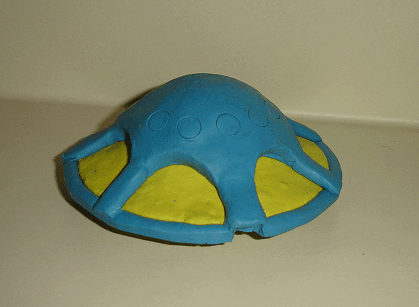 which would be capable of an approximate range of 7000 miles at subsonic speeds.” which would be capable of an approximate range of 7000 miles at subsonic speeds.”
A crude but adequate clay model of what the Strauch flying saucer looked like. To highlight different parts, the body is molded in blue and the rotating disc in yellow clay.
Paradoxically, it was the utter tangibility of UFOs over 1965-1967 that converted Hynek, but the multiplicity of UFO designs that prevented him from completely accepting a tangible ET hypothesis. (The multiplicity of Lightcraft designs actually didn’t exist, but as the three designs above were essentially glowing lights at night they were easily tailored and then embellished in the minds of thousands of impressionable witnesses and then molded in the hands of outright prevaricators and grandstanders, and the result was sheer mishmosh.) In The UFO Experience he still held to potential psychological explanations, as seen in the fact he included in his discussion the Kelly-Hopkinsville hobgoblin case of August 1955. After alluding to the work (Passport to Magonia) of his protégé, Jacques Vallee, about the similarities of modern UFO phenomenon to ancient mythology, he writes:
We are not, of course, justified in concluding that the Kelly creatures
stemmed from the imagination alone or, conversely, that the source of ancient
legends lie in the actual appearances of such creatures in the past or that real
humanoids were seen. As in other aspects of the entire UFO phenomenon,
the call is clearly for more study.
Coupled with his noncommittal approach on details, Hynek’s recent conversion must have been a sensitive subject. After the success of his 1972 book, opponents to some of his influence could use his relative novice standing to undermine his authority. He too must have realized there was a weak foundation to his appearance as the expert. In his 1977 book The Hynek UFO Report, he portrays himself as open-minded since the earliest days of the phenomenon. He had been an associate on the CIA sponsored 1953 Robertson Panel. As only an associate he was not asked to sign it. However, he wrote that had he been asked to he would have refused. “Even at that early date, when I was still much of a skeptic, I remember feeling that short shrift was being made of UFOs from a scientific standpoint. In retrospect, it is now clear that indeed it was.”
Of his interaction with Blue Book, he soon writes:
But I knew my place; I was a consultant, not a director or policy
setter. I knew, too, that to run counter to what I had observed to be
their “orders” would render me very shortly a persona non grata. This
I did not want: it was important to me to maintain my status on Blue
Book, for I was beginning at this time to suspect that there might just
be something to the UFO phenomenon after all and I wanted to be on
hand when “good” cases came along. There was no other way I could
gain access to the military reports, which weren’t being made public.
So, I bided my time.
This does make Hynek sound like the “intelligence agent” he likened himself to, but the early time period (1953) is simply not justified from his later comments. It was only in late 1966 that he started to shift to believing, and the move was slow and public thereafter. This shift, once again, was because of the then-secret operation of Lightcraft.
Yes, before Congress he said he had tried to remain open-minded since the beginning, but open-minded to what? What would have constituted a “good” case to Hynek anyway, especially throughout the 1950s? When he did finally express a belief that UFOs should be looked into further (1965), he did so because of the psychology of the individuals. Even as late as his Goddard speech (January 1967), he 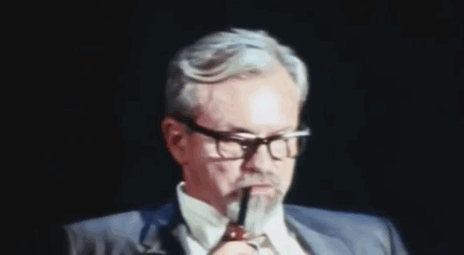 “strongly shied” away from the ET hypothesis. If all the above is true, what was he looking for in a case circa 1950s to consider it “good”? “strongly shied” away from the ET hypothesis. If all the above is true, what was he looking for in a case circa 1950s to consider it “good”?
Chewing thoughtfully on his pipe for the classic documentary UFOs: It Has Begun in 1974.
In his books, he presented himself as a faithful chronicler (he was), but he would not be a theorist. He proposed following the phenomenon in order to gain more data. In 1974, for UFOs: It Has Begun he suggests “I think we should also think of other possible hypotheses. Suppose there are such things as [drags thoughtfully on pipe] interlocking universes where forms of matter which don’t mesh with ours except under strange conditions.” Again:
We must always be aware of the fact that we may be testing
the wrong hypothesis. As for instance in the days when people
talked about stones falling from heaven. That was testing the wrong
hypothesis. Meteorites do exist. The phenomenon exists, but they’re
not stones that fall from heaven. They’re stones that the Earth collides
with when they’re in orbit around the Sun.
Because of the The Great Flap of 1965-1967 Hynek set out to document yet not explain a phenomenon that was real but followed no true logical progression. Those who set Lightcraft and similar devices into action over that period no doubt had the best of intentions during such a volatile and potentially deadly time in the Cold War, Vietnam, political assassinations, and the social and racial upheavals taking over America. They kept silent, and by doing so unintentionally allowed a terrible cult to gestate and grow to threatening proportions today. The fears and politics of that era are no longer relevant, and it is time to finally end the cult that Lightcraft created.
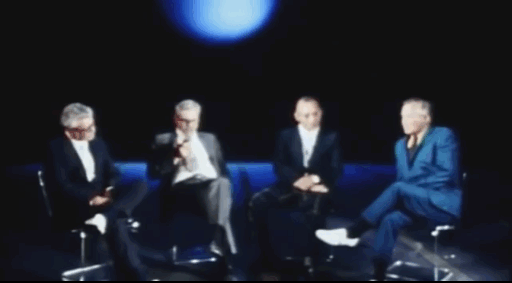
One of the last weighty roundtables in original UFOlogy was presented toward the end of UFOs: It Has Begun. Left to right, Lt. Col. Hector Quintanilla (chief of Blue Book 1963-1969), Dr. J. Allen Hynek, Lt. Col. Robert Friend (chief of Blue Book 1958-1963), and Al Chop. It is sobering to listen to their profound comments and realize how each was unsuspecting of black ops. Col. Friend later appeared on In Search of. . . (episode UFO Coverups) and said: “If there was a planned cover-up, then they were very successful in keeping it from me.”
We follow this tangible path beginning in 1965, not merely to document it but to prove why it has been the wrong path to take. We live at the end of this path, a path the nation took because UFOs were now starkly real. They were so real and undeniable that in 1967 Frank Edwards entitled his bestselling book: Flying Saucers— HERE and NOW!
Here this article amplified the significance of Lightcraft’s effect. Aside from the immense press the UFO flap generated in 1965-1967, it turned J. Allen Hynek and a number of other scientists, including Dr. James E. MacDonald, into powerful and respectable pro-UFO voices. From these UFO reports we developed the stereotype Close Encounters of the Second Kind— the rural traveler enveloped on his late night road by a blinding divine ray while a drone of a silhouette of otherworldly design moves overhead like an eclipse over our preconceived ideas of our place in the universe. . .
All that is blooming today in the UFO experience was seeded now. The alien abduction vogue needed the above Close Encounters of the Second Kind scenario fully established and believable in order to give us the Kitsch of the Third Kind, the horribly humanistic ‘We’re here to help’ benevolence while the average petit bourgeois is being probed. Deprived of objective evidence, hypnosis would become the next big UFO investigators’ tool, and we were treated to hundreds of lurid and salacious UFO abduction stories. It all seemed possible because. . . because UFOs seemed so real thanks to The Great Flap of 1965-1967. In essence, thanks to Lightcraft and the very earthly intelligence operators who kept mum.
The UFO “experience” of today no longer knows how much it owes to Michigan, the Midwest, and Lightcraft. Those 9 craft first seen over Warren AFB sped over the United States. Thousands of people were seeing them. The phenomenal events of those few years convinced the world that America was being vexed by UFOs and that it had no explanation for them. The Condon Committee gave the appearance of 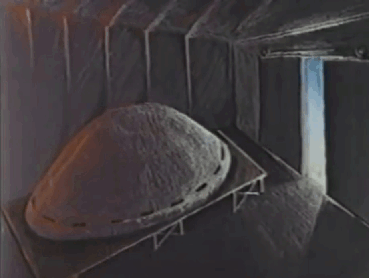 refuting it all. Yet they worded their conclusion carefully: the evidence indicated nothing beyond human engineering. They were right. refuting it all. Yet they worded their conclusion carefully: the evidence indicated nothing beyond human engineering. They were right.
Hynek’s civilian Center for UFO Studies offered this as a witness’ description of a saucer kept hidden at Wright-Patterson AFB. It’s a crude example of a Lightcraft, but it isn’t alien.
Pursuing the right path will eventually plunge us into the dark world of PsyOps, but before we go there to cascading darkness it is best we only introduce here an inference. Russia was being vexed at this time by such UFOs. So real were these sightings that even the usually tightlipped Soviets admitted they were studying them.
Back in the USA, this news only increased the importance of the subject to J. Allen Hynek. For his growing audience of converts, he insisted we must take UFOs seriously. The Soviets could learn more. We couldn’t be left out of “The UFO Gap,” as was the title of his Playboy article.
* * *
The Great Flap had largely caused Ooohs and Ahhhs over the Midwest in August 1965, but in September near Exeter, New Hampshire, the reality of these glowing, marvelous lights came in close. There was that tangibility and reality that filled the witnesses with conviction. So real were the UFO reports that followed for the next couple of years that people were willing to believe the saucers were capable of abducting people. Once the food of tabloids, the idea of alien abductions would become acceptable fare, and John Fuller became the conduit. The events at Exeter made it possible for him to publish the story of Betty and Barney Hill’s alleged abduction by the crew of a flying saucer on lonely Route 3 further upstate in New Hampshire. This incident would prove crucial. The book The Interrupted Journey came out in 1966, the apogee of the Great Flap, and from the recesses of hypnosis it would give us A Form of Alien. For the first time, society saw those who were behind the flying saucers and why they stalked lonely, rural roads late at night.
|